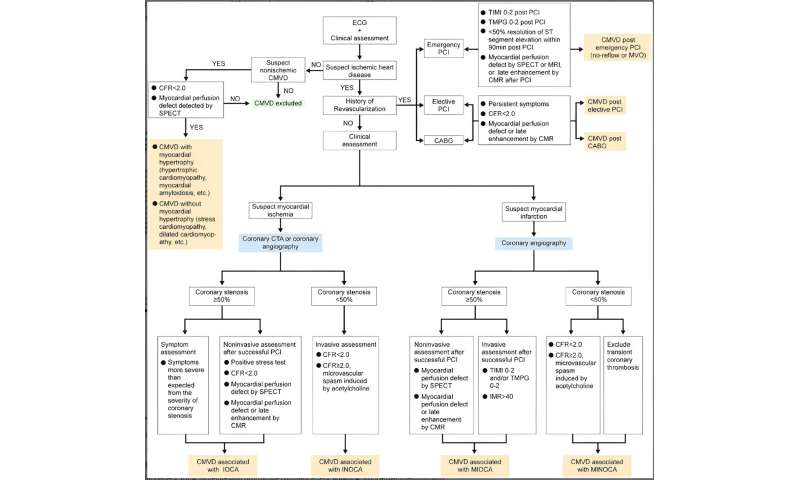New recommendations in Chinese expert consensus on the diagnosis and treatment of coronary microvascular diseases

The Chinese expert consensus on the diagnosis and treatment of coronary microvascular diseases (2023 Edition) was written by the members of the Basic Research Group, Atherosclerosis and Coronary Heart Disease Group, Interventional Cardiology Group, and Women's Heart Health Group of the Chinese Society of Cardiology. Dr. Cheng Zhang, Dr. Yundai Chen and Dr. Yun Zhang were the corresponding authors of this paper. "The major objective of this consensus was to standardize the diagnostic methods and therapeutic strategies of CMVD," says Dr. Yun Zhang, a senior cardiologist at Qilu Hospital of Shandong University, China.
As introduced by Dr. Yun Zhang, this consensus covered six areas: (1) definition, clinical classification, and epidemiology of CMVD; (2) pathogenesis of CMVD; (3) diagnostic techniques for CMVD; (4) clinical manifestations and diagnostic criteria of CMVD; (5) treatment of CMVD, and (6) future directions for CMVD research.
One important novelty of the 2023 consensus was a new classification of CMVD which included four major types and nine subtypes: (1) CMVD associated with myocardial ischemia including two subtypes: CMVD associated with INOCA (ischemia with non-obstructive coronary arteries) or with IOCA (ischemia with obstructive coronary arteries); (2) CMVD associated with myocardial infarction including two subtypes: CMVD associated with MINOCA (myocardial infarction with non-obstructive coronary arteries or with MIOCA (myocardial infarction with obstructive coronary arteries; (3) CMVD associated with coronary revascularization including three subtypes: CMVD associated with primary PCI (percutaneous coronary intervention), elective PCI or CABG (coronary artery bypass grafting); (4) CMVD associated with non-atherosclerotic heart disease including two subtypes: CMVD associated with or without myocardial hypertrophy.
The incidence of CMVD varied greatly among different types of CMVD. Except for CMVD associated with non-atherosclerotic heart disease, other types of CMVD were more common and had a worse prognosis in women. CMVD increased the risk of future cardiovascular events and was an independent predictor of these events. "Epidemiological studies on CMVD among different populations and ethnicities are needed", Dr. Zhang says.
Three pathogenetic mechanisms of CMVD were underscored: structural abnormalities of the coronary microcirculation, microvascular obstruction, and functional abnormalities of the coronary microcirculation.
Noninvasive diagnostic techniques of CMVD including transthoracic Doppler echocardiography (TTDE), single-photon emission computed tomography (SPECT), positron emission tomography (PET), and cardiovascular magnetic resonance (CMR) technologies were recommended in this consensus. Among them, PET remained the gold standard for non-invasive diagnosis of CMVD. However, CMR is gradually taking over as the gold standard for non-invasive assessment of CMVD. Myocardial contrast echocardiography (MCE) and computed tomographic perfusion (CTP) were the new recommendations for detecting CMVD. Coronary angiography, thermodilution technique and intracoronary Doppler flow velocity measurement were major invasive techniques for the diagnosis of CMVD. The clinical indications, diagnostic parameters and cutoff values for both non-invasive and invasive techniques were recommended according to ACC (American College of Cardiology)/AHA (American Heart Association) criteria for guideline writing. In addition, clinical manifestations, diagnostic criteria and diagnosis flow chart for each type of CMVD were specified to facilitate clinical applications.
The therapeutic strategy of CMVD included lifestyle modifications, pharmacological treatment and nonpharmacological treatment, which were recommended for each type of CMVD using classes for classification and levels of evidence as defined by ACC/AHA.
For patients with CMVD associated with INOCA, in addition to risk factor management, stratified medical therapy for CMVD was recommended because microvascular angina (MVA) and vasospastic angina (VSA) have different pathogenetic mechanisms and should be treated specifically. Similarly, for patients with CMVD associated with IOCA and MINOCA, stratified therapies for MVA and VSA were also recommended.
Treatment of CMVD after successful interventional therapy for acute myocardial infarction (AMI) was emphasized in the current consensus. Apart from pharmacological treatment, nonpharmacological treatment including ischemic preconditioning and pressure-controlled intermittent coronary sinus occlusion (PICSO) were recommended. "The final goal of reperfusion therapy in patients with AMI is to prevent CMVD and protect cardiac function", adds Dr. Zhang.
Treatment of CMVD associated with non-atherosclerotic heart disease included treatment of both CMVD and primary diseases.
To sum up, the Chinese expert consensus on the diagnosis and treatment of coronary microvascular diseases (2023 Edition) comprehensively expounded on scientific issues related to CMVD. "We hope that this expert consensus will better standardize diagnosis and treatment of CMVD in clinical practice and further expedite the research progress of CMVD in both basic and clinical scenarios", Dr. Yun Zhang concluded.
More information:
Wenqiang Chen et al, Chinese expert consensus on the diagnosis and treatment of coronary microvascular diseases (2023 Edition), MedComm (2023). DOI: 10.1002/mco2.438
Provided by Sichuan International Medical Exchange and Promotion Association